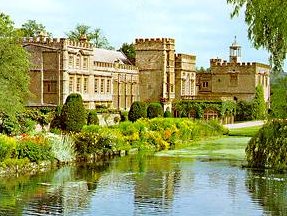|
Although not within the parish of Winsham, Forde Abbey lies adjacent
to the southwest corner of the parish separated only by the river Axe. The abbey has had great influence on Winsham and its people for over 800
years, and therefore rightly deserves it place in the Winsham Web Museum.
Built of deep golden ironstone and today set in spectacular gardens and grounds on the banks of the River Axe, the abbey was founded by Cistercian
monks in 1140-41 and was one of
the most significant Cistercian monasteries in England. The monastery
developed between the 12th and 16th centuries.
 Thomas Chard, the last of the thirty-two abbots, devoted much time
and energy to repairing and reconstructing the fabric of the Abbey
building and enhancing it with a
splendid Gothic façade. The monks left at the Dissolution in 1539 and
the church, together with the monastery's guest wing and three
sides of the cloisters, was destroyed by Henry VIII. Abbot Chard, his
building works unfinished, was subsequently made vicar of nearby
Thorncombe. Thomas Chard, the last of the thirty-two abbots, devoted much time
and energy to repairing and reconstructing the fabric of the Abbey
building and enhancing it with a
splendid Gothic façade. The monks left at the Dissolution in 1539 and
the church, together with the monastery's guest wing and three
sides of the cloisters, was destroyed by Henry VIII. Abbot Chard, his
building works unfinished, was subsequently made vicar of nearby
Thorncombe.
The building stood empty and neglected for over a hundred years. In 1649
the wealthy lawyer and Parliamentarian Attorney General to Oliver Cromwell at the time of the
Commonwealth, Sir Edmund Prideaux, bought the
abbey and attempted to transform it into an Italian palazzo. By adding
state apartments above the monastic cloisters and transforming the
principal rooms, he carefully remodelled it into a stylish country mansion,
incorporating much of Abbot Chard's earlier work.
While the
exterior changed little, the interiors were panelled and lavishly
covered in decorative plasterwork. Ten ornate plaster ceilings (dating
from 1650) are possibly unique in Great
Britain. The Great Hall boasts a fine oak panelled ceiling while the
Grand Saloon, with elegant furnishings, contains one of the best surviving sets
of Mortlake tapestries in Europe. The famous
tapestries that hang in the Grand Saloon are copies of the cartoons
drawn by Raphael for the Sistine Chapel. (This set were ordered by Sir
Edmund Prideaux from the factory at Mortlake but only reached Forde when
Queen Anne presented them to Sir Francis Gwyn, who married Prideaux’s
granddaughter, in recognition of his services as Secretary of State for
War. When the contents of the house were sold in 1846
these outstanding Mortlake tapestries were all that remained. The Grand
Staircase is highly decorated. No major alterations
have been carried out since and Forde retains its baroque elegance to
this day.
Forde later passed to the Gwyn family who died out in 1846. The house
was subsequently sold twice in 20 years - the second time bought by the
Roper family, the present owners.
The 12th century Cistercian Chapter House, once the
central administration centre of the abbey, has been a Chapel since 1650.
The 13th century Undercroft today houses the restaurant under its
vaulted arches. The Dormitory range is also 13th century and, although sliced in half down its length by the creation of
a suite of bedrooms during the 18th century, still extends 100ft. It
retains the original 14th century oak roof but this is now hidden by a plaster ceiling.
The Tower and the Grand Hall date from 1520.
Forde Abbey, today, is possibly the most complete Monastic building used as a
house in Great Britain and is believed to be one of the oldest
inhabited historic houses of England open to the public today.
The landscaped gardens contain water falls and statues created by Sir Francis Gwyn
in 1700. A ha-ha, or sunken boundary wall, of about 1750 divides garden
from the parkland. Today the Award winning gardens extend to 30 acres.
From the front of the house one sees a Victorian garden which
draws upon the monastic remains. There is a large herbaceous
border beside a canal, a topiary enclosure, a kitchen garden, a rock
garden by Jack Drake, a very good bog garden and a 15th century fish pond made by the
monks.
|